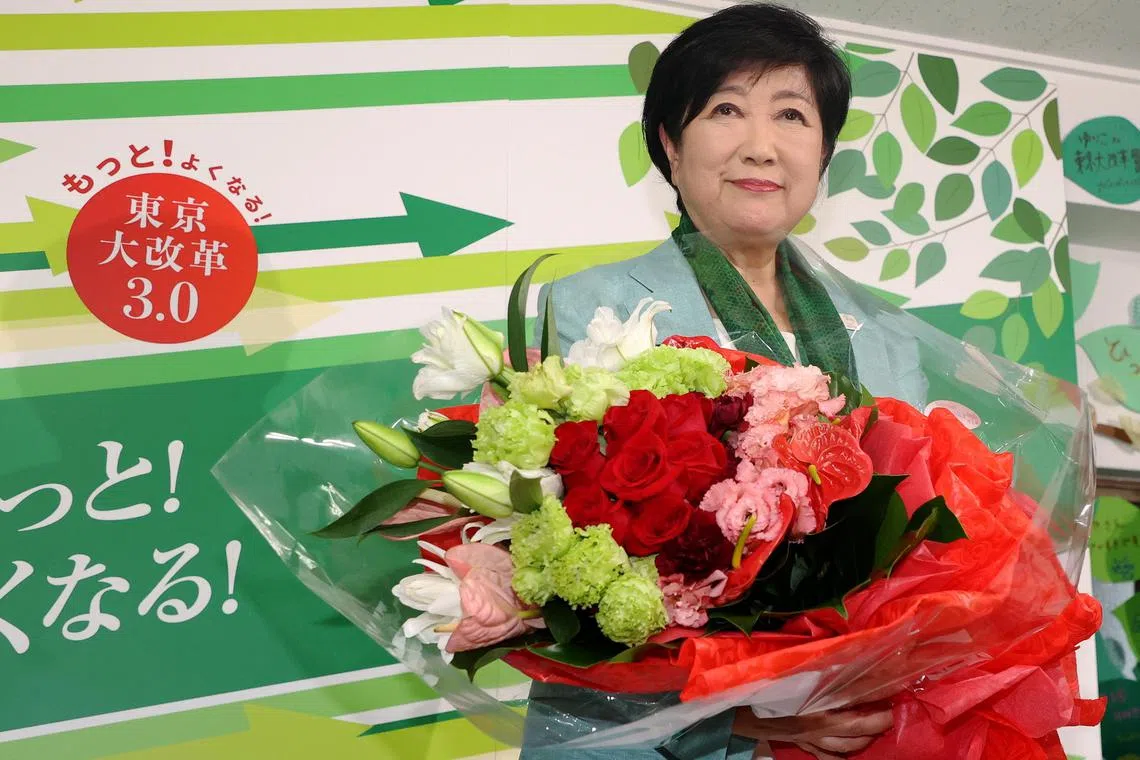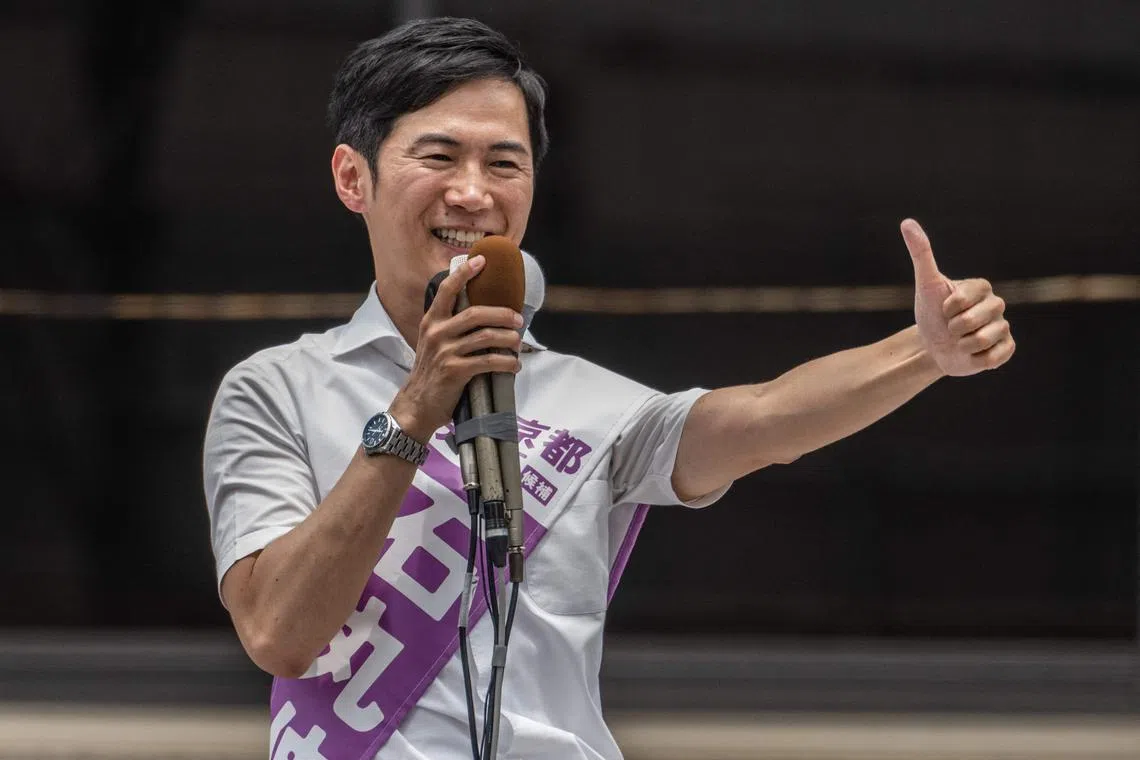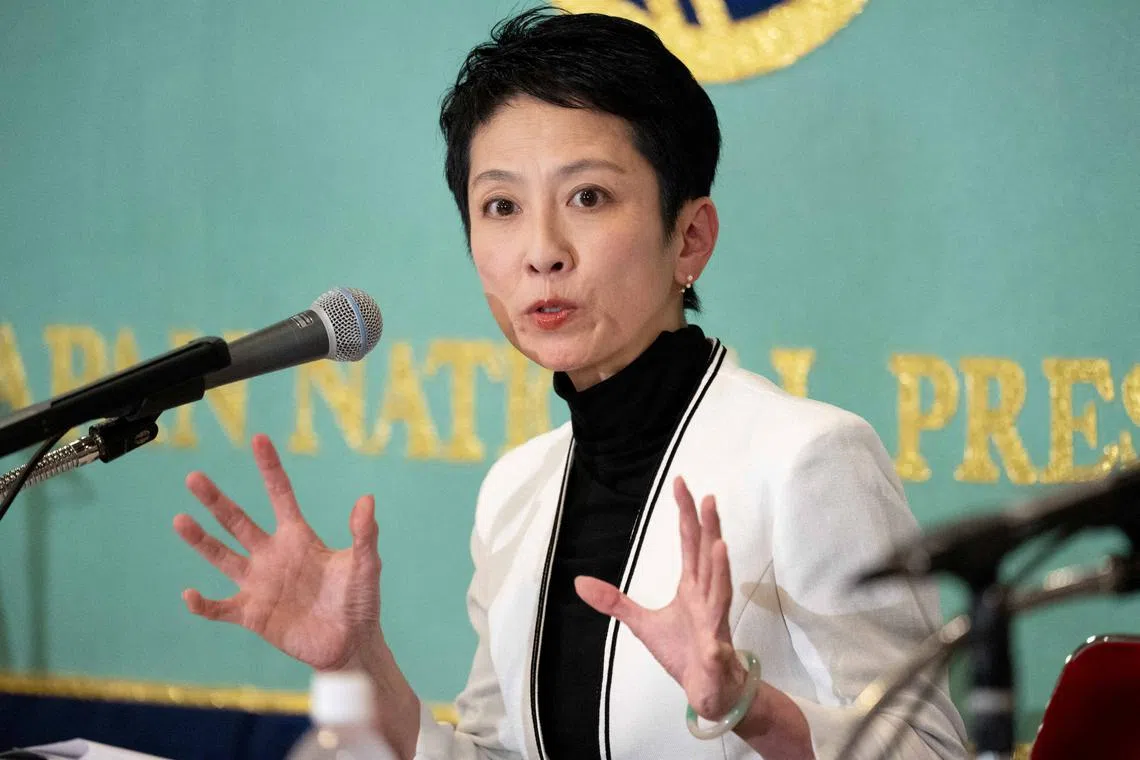News analysis
Yuriko Koike wins third term as Tokyo governor in boost for LDP
Sign up now: Get insights on Asia's fast-moving developments

Tokyo Governor Yuriko Koike celebrates after winning a third straight term in the Tokyo gubernatorial election on July 7.
PHOTO: EPA-EFE
Follow topic:
TOKYO – Incumbent Tokyo Governor Yuriko Koike won a third straight term on July 7 to lead one of the world’s largest cities, in a victory that will bring relief to the ruling Liberal Democratic Party (LDP).
The 71-year-old, who was first elected as Tokyo’s first female governor in 2016, emerged the runaway winner with 42.8 per cent of the ballots cast, according to the final tally.
Ms Koike’s victory “is a great boost for us in upcoming elections”, said Ms Yuko Obuchi, the LDP’s election strategy committee chief, on July 7 after the release of exit poll results.
The powerful Lower House of the Diet must be dissolved by October 2025 for elections, while the next polls for the fixed-term Upper House will be in July 2025.
“But at the same time, I feel that restoring trust in politics is still a work in progress,” she added.
The results were surprising in how the main opposition Constitutional Democratic Party of Japan (CDP) failed to capitalise on national unhappiness with the LDP and Prime Minister Fumio Kishida,
The CDP came into the July 7 election on a victory streak, having ousted LDP incumbents
Ms Koike, the conservative former defence and environment minister, quit the LDP on acrimonious terms in 2016 but has since largely reconciled with the party. She was stealthily supported by the LDP in her re-election campaign, having rejected overt backing over concerns that it would backfire on her.
Yet, what was widely touted to be a two-horse contest
Ms Renho – who typically goes by only her first name – came in third, with 18.8 per cent.
Mr Shinji Ishimaru, 41, who tapped his relative youth and political independence to his advantage and won over younger voters with his prominent social media presence, got 24.3 per cent of the vote.
This has prompted soul-searching within the CDP: Ms Renho was a national politician and Mr Ishimaru, a relatively unknown entity, before hustings began.

Tokyo gubernatorial election candidate and former mayor of Akitakata city of Hiroshima prefecture Shinji Ishimaru delivers a speech during an election campaign in Tokyo.
PHOTO: AFP
Buoyed by the results, Mr Ishimaru, the former banker-turned-mayor of Akitakata city in Hiroshima, told reporters on July 7 that he will consider a run in national politics: “For example, the Lower House First District of Hiroshima, which is Mr Kishida’s constituency.”
Experts told The Straits Times that while Ms Koike benefited from incumbent advantage, having led Tokyo through the Covid-19 pandemic and overseen the delayed Olympic and Paralympic Games in 2021, the result will take the wind out of the CDP’s sails.
“It’s a good result for the LDP, not only in that Koike won, but also that Renho had a disappointing showing,” Sophia University political scientist Koichi Nakano told ST.
Throughout the campaign, Ms Renho had attacked Ms Koike’s ties with the LDP and sought to draw attention to the scandals that envelop Mr Kishida’s administration, to no avail.
“I think there was unfounded optimism,” Dr Nakano said. “Ultimately, it wasn’t clear what Renho was standing for. Other than attacking Koike, she failed to project a positive proposal in a way that was understandable.”

NHK’s forecasts showed Ms Renho Saito, a 56-year-old former Upper House lawmaker, coming in third.
PHOTO: REUTERS
The Tokyo governor, one of the most high-profile roles in Japanese politics, oversees a prefecture with 14.17 million residents – among them, 11.53 million voters – that contributes 20.7 per cent of Japan’s gross domestic product.
Beyond the bustling urban metropolis, Ms Koike’s jurisdiction also stretches westwards to the mountainous Okutama region and southwards to the remote Unesco-recognised Ogasawara island chain.
Altogether, Tokyo’s economic output of US$113.7 trillion (S$153.5 trillion) in the year ended March 2022 was larger than the size of Turkey’s economy, with Tokyo ranked as the world’s 18th-largest economy if it were a country, according to prefecture data.
Professor Mikitaka Masuyama from the National Graduate Institute for Policy Studies said he felt that the LDP should not read too much into Ms Koike’s victory.
“I think the declining trend for Kishida continues, and Kishida may have a difficult time in the September presidential race,” he said, referring to the internal LDP polls to choose the party’s leader.
Amid plenty of unrest within the party, Economic Security Minister Sanae Takaichi and Digital Transformation Minister Taro Kono are among the likely challengers aiming to unseat him.
“Koike’s victory has nothing to do with the LDP’s momentum to recover this decline in popularity, and people certainly are still disappointed about the money-handling of the LDP politicians,” Prof Masuyama added.
Mr Kishida’s Cabinet support is hovering around 25 per cent, with populist measures such as tax rebates and subsidies failing to resuscitate his popularity.
Prof Masuyama noted that Ms Koike had effectively benefited from a split vote between Mr Ishimaru, who announced his candidacy in May, and Ms Renho, who announced hers in June.
Altogether, the Tokyo gubernatorial election was contested by a crowded field of 56 candidates, although many were “joke” candidates
Voter turnout was 60.62 per cent. This is higher than the 55 per cent who voted in the last Tokyo gubernatorial election in July 2020.


